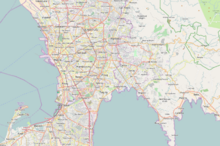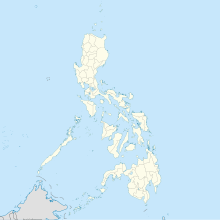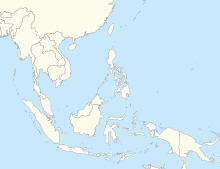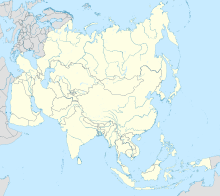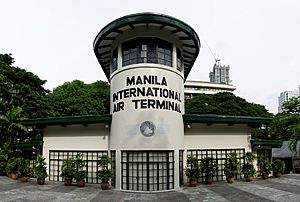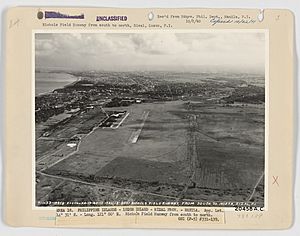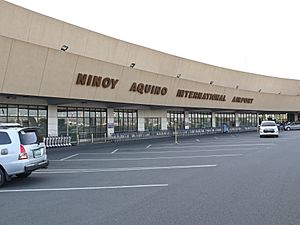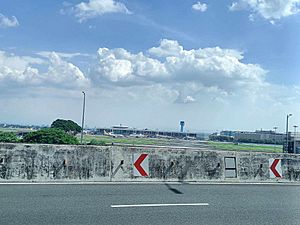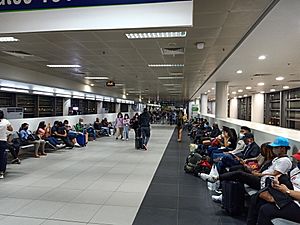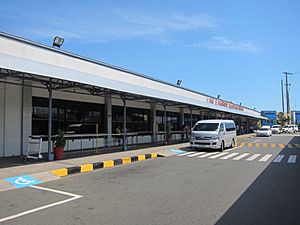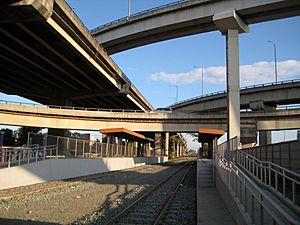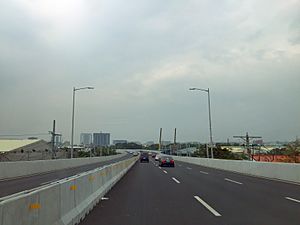Ninoy Aquino International Airport facts for kids
Quick facts for kids
Ninoy Aquino International Airport
Paliparang Pandaigdig ng Ninoy Aquino
|
|||||||||||||||
|---|---|---|---|---|---|---|---|---|---|---|---|---|---|---|---|
 |
|||||||||||||||
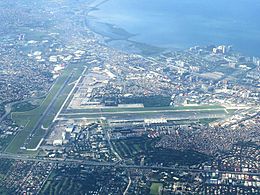
MNL in January 2023
|
|||||||||||||||
| Summary | |||||||||||||||
| Airport type | Public / Military | ||||||||||||||
| Owner/Operator | Manila International Airport Authority | ||||||||||||||
| Serves | Greater Manila Area | ||||||||||||||
| Location | Parañaque and Pasay, Metro Manila, Philippines | ||||||||||||||
| Opened | 1948 | ||||||||||||||
| Hub for |
|
||||||||||||||
| Focus city for | Philippines AirAsia | ||||||||||||||
| Time zone | PHT (UTC+08:00) | ||||||||||||||
| Elevation AMSL | 23 m / 75 ft | ||||||||||||||
| Coordinates | 14°30′30″N 121°01′11″E / 14.50833°N 121.01972°E | ||||||||||||||
| Map | |||||||||||||||
| Runway | |||||||||||||||
|
|||||||||||||||
| Statistics (2022) | |||||||||||||||
|
|||||||||||||||
|
Source: Manila International Airport Authority
|
|||||||||||||||
Ninoy Aquino International Airport (NAIA), originally called Manila International Airport (MIA), is the main airport for international flights in the Manila area of the Philippines. It's located between the cities of Pasay and Parañaque. The airport is about 7 kilometers (4.3 miles) south of Manila.
NAIA is the main entry point for people traveling to the Philippines. It's a major hub for airlines like AirSWIFT, Cebgo, Cebu Pacific, PAL Express, and Philippine Airlines. It's also the main base for Philippines AirAsia.
The airport was named after a famous Philippine Senator, Benigno "Ninoy" Aquino Jr.. He was killed at the airport on August 21, 1983. The Manila International Airport Authority (MIAA) manages NAIA.
NAIA and Clark International Airport both serve the Manila area. Clark Airport is in Pampanga and is often used by airlines that offer lower prices. NAIA is currently very busy and handles more passengers than it was built for. Because of this, new airports are being built to help reduce the crowding.
Contents
Airport History
How the Airport Started
Manila's first airport was Grace Park Airfield, opened in 1935. It was used for early domestic flights. Later, Nielson Airport opened in 1937. After World War II, airport operations moved to the current location, which was then called Nichols Field. This new spot was chosen because it was flat and already had a runway (Runway 13/31). The first small terminal was built there in 1948.
In 1954, a longer runway (Runway 06/24) was built for international flights. A new international terminal opened in 1961. This terminal was damaged by a fire in 1972. A new, smaller terminal was built the next year. In 1981, Terminal 1, a much bigger terminal, was opened.
Why the Airport Was Renamed
On August 21, 1983, a well-known politician named Benigno Aquino Jr. was killed at the airport. He was returning to the Philippines from another country. To honor him, the airport was officially renamed Ninoy Aquino International Airport in 1987. Today, you can find a memorial plaque at Gate 8 (now Gate 11) where this sad event happened.
Growing the Airport
Plans to build new terminals started in 1989 to handle more passengers. Construction for Terminal 2 began in 1995 and it opened in 1999.
Building Terminal 3
A third terminal was planned, but its construction faced many delays. There were disagreements and technical problems. Terminal 3 finally opened partially in 2008 and became fully operational in 2014. This new terminal greatly increased the airport's capacity.
Plans to Improve the Airport
Over the years, many groups have suggested ways to improve NAIA and reduce crowding. These plans include making the current terminals better and even building new runways. The goal is to make the airport more efficient and comfortable for travelers.
Changing Terminal Assignments
To help with crowding, the airport started a program called STAR (Schedule and Terminal Assignment Rationalization). The idea was to have Terminals 1 and 3 handle only international flights, and Terminals 2 and 4 handle only domestic flights. This helps organize flights better.
This program has been put into action step by step. For example, in 2023, more international airlines moved to Terminal 3, and some Philippine Airlines international flights moved to Terminal 1. Terminal 2 is now mainly for domestic flights. These changes help passengers find their way around and make their travel smoother.
Airport Terminals
Terminal 1
Terminal 1 is about 73,000 square meters (785,765 sq ft) in size. It was designed to handle six million passengers each year. This terminal opened in 1982 and is the second oldest at the airport. It's sometimes called the "Ninoy Aquino Terminal" because of the historical event that happened there.
Terminal 1 has been improved over the years to handle more passengers. Many international airlines have moved to Terminal 3 to help reduce crowding here. Today, Terminal 1 serves all international flights for Philippine Airlines. It also serves many other international airlines like Air China, Asiana Airlines, Japan Airlines, and Korean Air.
Terminal 2
Terminal 2 is located on the old MIA Road and covers about 75,000 square meters (807,293 sq ft). It started operating in 1999 and is also known as the 'Centennial Terminal'. This name celebrates 100 years of Philippine independence.
The terminal has 12 jet bridges, which are walkways that connect the terminal directly to the airplane. It can handle about 7.5 million passengers each year. Since 2023, its capacity has been increased to ten million passengers per year. The terminal has been updated and expanded, adding more space.
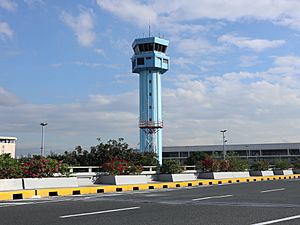
Terminal 2 used to be the main hub for Philippine Airlines and PAL Express, handling both domestic and international flights. But since July 2023, Terminal 2 is now used only for domestic flights by PAL Express, Philippine Airlines, Philippines AirAsia, and Royal Air Philippines.
Terminal 3
Terminal 3 is the newest and largest terminal at NAIA. It's huge, covering 182,500 square meters (1,964,400 sq ft) and stretching 1.2 kilometers (0.75 miles) long. It opened partially in 2008 and fully in 2014. This terminal added space for 13 million more passengers.
Terminal 3 has 20 jet bridges and four remote gates. These remote gates use special buses to take passengers to and from the planes. The terminal can handle 33,000 passengers per day. Since 2017, there's a 220-meter (722 ft) long indoor walkway called Runway Manila that connects Terminal 3 to Newport City.
Terminal 3 is mostly used by Cebu Pacific for both domestic and international flights. It also serves international flights for the AirAsia Group and many other foreign airlines.
Terminal 4
Terminal 4, also known as the Manila Domestic Passenger Terminal, is the airport's oldest and smallest terminal. It was built in 1948. It's located near the north end of Runway 13/31.
Since 2023, Terminal 4 is used specifically for planes with propellers, called turboprop aircraft. It uses ground-loaded gates, meaning passengers walk directly to the plane on the ground. This terminal can handle up to three million passengers each year. It mainly hosts domestic flights by regional airlines like AirSWIFT, Cebgo, and Sunlight Air.
During the COVID-19 pandemic, Terminal 4 was temporarily closed to save money. It was even used as a vaccination site for airport workers. It reopened for flights on March 28, 2022.
Airport Features
Runways
NAIA has two main runways. The primary runway is 3,737 meters (12,260 ft) long and 60 meters (200 ft) wide. It's called Runway 06/24. The secondary runway is 2,258 meters (7,408 ft) long and 45 meters (148 ft) wide, called Runway 13/31.
The primary runway is used for most flights. The secondary runway is often used by smaller planes and propeller aircraft. Runway 13/31 was closed for repairs in 2020 and reopened in 2021 with a new taxiway.
Future Runway Plans
There have been ideas to build a third runway next to the existing Runway 06/24. This new runway could be 2,100 meters (6,900 ft) long. It would allow more planes to land and take off, increasing the airport's capacity. Another idea is to use Sangley Point in Cavite as a third runway for the Manila area.
Maintenance
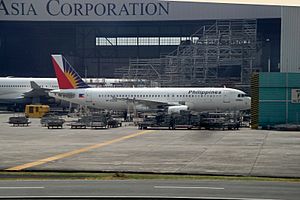
Lufthansa Technik Philippines (LTP) is a company at the airport that helps maintain, repair, and overhaul aircraft. They work on many types of planes, including the Airbus A320 family and A330/A340 aircraft. They have large hangars and workshops for these services. They even have a special hangar for the very large Airbus A380 aircraft.
Another company, Aviation Partnership (Philippines) Corporation, also provides aircraft maintenance services at the airport, especially for Cebu Pacific planes.
Training
Philippine Airlines (PAL) has a special training center at the airport called the PAL Learning Center. Here, pilots and flight attendants get their training. The center also has flight simulators, like a practice cockpit for an Airbus A320, to help pilots learn.
Airlines and Destinations
NAIA serves many airlines that fly to different cities around the world and within the Philippines.
Passenger Flights
| Airlines | Destinations |
|---|---|
| Air China | Beijing–Capital, Chengdu–Tianfu |
| Air Juan | Busuanga |
| Air Niugini | Port Moresby |
| AirAsia | Kuala Lumpur–International |
| AirSWIFT | Busuanga, El Nido, Sicogon, Tablas |
| All Nippon Airways | Tokyo–Haneda, Tokyo–Narita |
| Asiana Airlines | Seoul–Incheon |
| Cathay Pacific | Hong Kong |
| Cebgo | Busuanga, Caticlan, Cebu, Legazpi, Masbate, Naga, San Jose (Mindoro), Siargao |
| Cebu Pacific | Bacolod, Bandar Seri Begawan, Bangkok–Suvarnabhumi, Beijing–Capital, Butuan, Cagayan de Oro, Caticlan, Cauayan, Cebu, Cotabato (suspended), Davao, Denpasar, Dipolog, Dubai–International, Dumaguete, Fukuoka, General Santos, Guangzhou, Hanoi, Ho Chi Minh City, Hong Kong, Iloilo, Jakarta–Soekarno-Hatta, Kalibo, Kota Kinabalu, Kuala Lumpur–International, Laoag, Legazpi, Macau, Melbourne, Nagoya–Centrair, Osaka–Kansai, Ozamiz, Pagadian, Puerto Princesa, Roxas, Seoul–Incheon, Shanghai–Pudong, Shenzhen, Singapore, Sydney, Tacloban, Tagbilaran, Taipei–Taoyuan, Tokyo–Narita, Tuguegarao, Virac, Xiamen, Zamboanga |
| China Airlines | Kaohsiung, Taipei–Taoyuan |
| China Eastern Airlines | Shanghai–Pudong |
| China Southern Airlines | Guangzhou |
| Emirates | Dubai–International |
| Ethiopian Airlines | Addis Ababa |
| Etihad Airways | Abu Dhabi |
| EVA Air | Taipei–Taoyuan |
| Gulf Air | Bahrain |
| Hong Kong Airlines | Hong Kong |
| Japan Airlines | Tokyo–Haneda, Tokyo–Narita |
| Jeju Air | Seoul–Incheon |
| Jetstar Asia | Osaka–Kansai (resumes November 24, 2023), Singapore |
| Jetstar Japan | Nagoya–Centrair, Tokyo–Narita |
| KLM | Amsterdam, Kuala Lumpur–International (ends October 28, 2023) |
| Korean Air | Seoul–Incheon |
| Kuwait Airways | Kuwait City |
| Malaysia Airlines | Kuala Lumpur–International |
| Oman Air | Muscat |
| PAL Express | Bacolod, Basco, Busuanga, Butuan, Cagayan de Oro, Calbayog, Catarman, Caticlan, Cebu, Cotabato (suspended), Davao, Dipolog, Dumaguete, General Santos, Iloilo, Kalibo, Laoag, Legazpi, Naga, Ozamiz, Pagadian, Puerto Princesa, Roxas, San Jose de Buenavista, Siargao, Tacloban, Tagbilaran, Zamboanga |
| Philippine Airlines | Bangkok–Suvarnabhumi, Beijing–Capital, Brisbane, Busan, Cebu, Dammam, Davao, Denpasar, Doha, Dubai–International, Fukuoka, General Santos, Guam, Guangzhou, Hanoi, Ho Chi Minh City, Hong Kong, Honolulu, Jakarta–Soekarno-Hatta, Kuala Lumpur–International, Los Angeles, Macau, Melbourne, Nagoya–Centrair, New York–JFK, Osaka–Kansai, Perth, Phnom Penh, Port Moresby, Quanzhou, Riyadh, San Francisco, Seoul–Incheon, Shanghai–Pudong, Singapore, Sydney, Taipei–Taoyuan, Tokyo–Haneda, Tokyo–Narita, Toronto–Pearson, Vancouver, Xiamen Seasonal charter: Medina, Yangyang |
| Philippines AirAsia | Bacolod, Bangkok–Don Mueang, Cagayan de Oro, Caticlan, Cebu, Davao, Denpasar, Guangzhou, Hong Kong, Iloilo, Kalibo, Kaohsiung, Kota Kinabalu, Macau, Osaka–Kansai, Puerto Princesa, Roxas, Seoul–Incheon, Shanghai–Pudong, Shenzhen, Tacloban, Tagbilaran, Taipei–Taoyuan, Tokyo–Narita |
| Qantas | Sydney |
| Qatar Airways | Doha |
| Royal Air Philippines | Caticlan, Lal-lo, Nanning |
| Royal Brunei Airlines | Bandar Seri Begawan |
| Saudia | Jeddah, Riyadh |
| Scoot | Singapore |
| Singapore Airlines | Singapore |
| SkyJet Airlines | Busuanga, San Vicente |
| Starlux Airlines | Taipei–Taoyuan |
| Sunlight Air | Charter: Busuanga, Camiguin, Caticlan, Naga, San Vicente, Siargao |
| Thai Airways International | Bangkok–Suvarnabhumi |
| Turkish Airlines | Istanbul |
| United Airlines | Guam, Koror, San Francisco (resumes October 30, 2023) |
| XiamenAir | Quanzhou, Xiamen |
| Zipair Tokyo | Tokyo–Narita |
Cargo Flights
| Airlines | Destinations |
|---|---|
| Air Hong Kong | Hong Kong |
| ANA Cargo | Tokyo–Narita |
| China Airlines Cargo | Singapore, Taipei–Taoyuan |
| Hong Kong Air Cargo | Hong Kong |
| Korean Air Cargo | Seoul–Incheon, Singapore |
| MASkargo | Kuala Lumpur–International |
| SF Airlines | Shenzhen |
| YTO Cargo Airlines | Hangzhou, Shenzhen |
Airport Statistics
Here's a look at how many passengers, flights, and cargo the airport handles each year. Data from Airports Council International and the Manila International Airport Authority.
| Year | Passengers | % change | Aircraft movements | % change | Cargo volume (in tonnes) | % change |
|---|---|---|---|---|---|---|
| 2003 | 12,955,809 | N/A | N/A | N/A | N/A | |
| 2004 | 15,186,521 | N/A | N/A | N/A | N/A | |
| 2005 | 16,216,031 | N/A | N/A | N/A | N/A | |
| 2006 | 17,660,697 | N/A | N/A | N/A | N/A | |
| 2007 | 20,467,627 | N/A | N/A | N/A | N/A | |
| 2008 | 22,253,158 | N/A | N/A | N/A | N/A | |
| 2009 | 24,108,825 | 186,966 | 348,994.25 | |||
| 2010 | 27,119,899 | 200,107 | 425,382.71 | |||
| 2011 | 29,552,264 | 217,743 | 410,377.05 | |||
| 2012 | 31,878,935 | 235,517 | 460,135.15 | |||
| 2013 | 32,865,000 | 237,050 | 457,077.17 | |||
| 2014 | 34,015,169 | 236,441 | 520,402.63 | |||
| 2015 | 36,681,601 | 249,288 | 586,890.53 | |||
| 2016 | 39,516,782 | 258,313 | 630,165.69 | |||
| 2017 | 42,022,484 | 258,366 | 662,256.99 | |||
| 2018 | 45,082,544 | 259,698 | 738,697.94 | |||
| 2019 | 47,898,046 | 277,530 | 721,708.09 | |||
| 2020 | 11,145,614 | 91,067 | 533,955.78 | |||
| 2021 | 8,015,385 | 121,095 | 588,370.92 | |||
| 2022 | 30,961,467 | 246,724 | 402,732.26 |
- Notes
Getting Around the Airport
Between Terminals
The MIAA operates a free shuttle bus service that connects all the terminals. This is helpful for passengers who need to catch connecting flights from different terminals. Philippine Airlines also has its own shuttle service between Terminals 1, 2, and 3.
To and From the Airport
Bus Services
The UBE Express offers a special bus service that connects the airport terminals to hotels and shopping areas in Manila and nearby cities. There are also regular city bus routes that go to and from the airport.
Jeepney Services
All four terminals are also served by local jeepney routes. These are popular public transportation vehicles in the Philippines.
Train Connections
You can reach the airport indirectly by train. The Baclaran station of the Manila LRT Line 1 and the Nichols railway station of the Philippine National Railways are both close to the airport complex.
Road Access
The NAIA Expressway/Skyway is a special elevated road that connects the airport to other parts of Metro Manila. It has ramps that lead directly to Terminals 1, 2, and 3. This makes it easier for cars and buses to get to and from the airport.
Renaming Discussions
There have been several discussions about changing the airport's name back to Manila International Airport. Some people believe the airport's name should represent the Filipino people. Others have suggested naming it after former president Ferdinand Marcos. However, the Supreme Court has upheld the current name, Ninoy Aquino International Airport.
Airport Accidents and Incidents
Airports, like any busy transportation hub, can sometimes have accidents or incidents. Here are a few notable ones that have happened at or near NAIA:
- On July 25, 1971, a cargo plane crashed into Mount Kamunay while approaching the airport. All four people on board died.
- On February 7, 1980, a China Airlines plane overshot the runway and caught fire during landing, causing two deaths.
- On September 15, 1981, a Korean Airlines plane went past the end of the runway during takeoff and hit a fence. Forty passengers and crew were injured.
- On May 11, 1990, a Philippine Airlines plane had an explosion in its fuel tank while preparing for takeoff. Eight people died.
- On May 18, 1990, a small passenger plane crashed into a residential area shortly after takeoff due to an engine problem. All 21 people on board and 4 people on the ground were killed.
- On November 11, 2002, a Laoag International Airlines plane had engine trouble shortly after takeoff and had to ditch into the sea. 19 of the 34 people on board died.
- On December 10, 2011, a cargo plane crashed into houses near a school after takeoff. At least 14 people died, and many houses caught fire.
- On August 16, 2018, a Xiamen Airlines plane skidded off the runway during heavy rain. All 157 passengers and crew were safe.
- On March 29, 2020, a medical evacuation plane caught fire on the runway during takeoff. All eight people on board died.
- On January 1, 2023, a power outage at the airport's air traffic control center caused many flight cancellations and delays, affecting thousands of passengers.
- On May 1, 2023, another power outage led to 48 Cebu Pacific flight cancellations.
- On June 10, 2023, a 37-minute power outage affected Terminal 3, causing delays.
Images for kids
-
Cebu Pacific and Philippines AirAsia Airbus A320s at the remote gates of Terminal 3.
-
The airport's control tower in front of Terminal 2.
-
An Airbus A320-200 of PAL Express at a maintenance hangar of Lufthansa Technik Philippines.
 In Spanish: Aeropuerto Internacional Ninoy Aquino para niños
In Spanish: Aeropuerto Internacional Ninoy Aquino para niños


